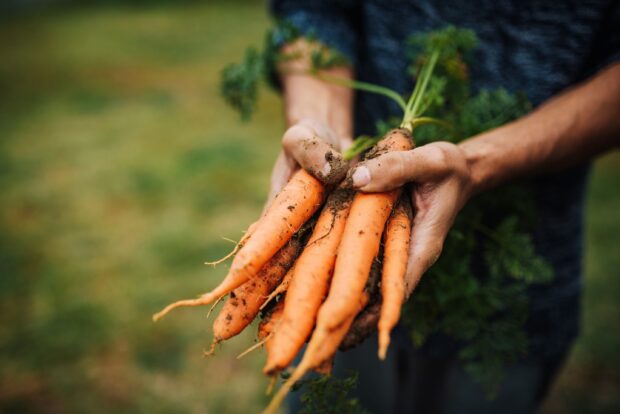Harvesting Gold: A Close Look at Carrot Harvesting Machinery
5 min read
Carrots, often referred to as the ‘gold’ of the vegetable world, are a staple in many diets across the globe. Their vibrant orange hue, crunchy texture, and sweet taste have made them a favorite for both raw and cooked dishes. But have you ever wondered how these underground treasures are harvested on a large scale?
The answer lies in the marvel of modern machinery. In this post, we’ll delve deep into the world of carrot harvesting machinery, exploring how technology has revolutionized the way we bring this golden vegetable from the field to our plates.
The Traditional Method: Hand Harvesting
Before the advent of machinery, carrots were harvested manually. Workers would use forks or spades to loosen the soil around the carrots and then pull them out by hand. This method was labor-intensive, time-consuming, and often resulted in a significant amount of crop damage. As the demand for carrots grew, it became clear that a more efficient method was needed.
Additionally, the manual process required a keen eye to identify mature carrots ready for harvest. The workers had to be skilled, ensuring they didn’t leave behind any carrots or pull them out too early. The communal aspect of hand harvesting also fostered a sense of community among workers, as they shared stories and experiences while working side by side in the fields.
Enter the Carrot Harvester
The modern carrot harvester is a testament to human ingenuity. These machines are designed to extract carrots from the ground with minimal damage, ensuring that the produce reaches consumers in the best possible condition.
With the introduction of these machines, the agricultural landscape saw a significant shift in productivity and efficiency. Not only did they reduce the need for manual labor, but they also ensured consistent and uniform harvesting.
The evolution from hand harvesting to machine-driven methods marked a pivotal moment in agricultural history, showcasing the power of innovation in meeting growing demands.
1. Top Lifter Harvesters
The most common type of carrot harvester is the top lifter. Equipped with rubber belts, these machines grip the carrot tops and gently pull the carrots from the ground. As the carrots are lifted, a series of rotating blades cut off the tops, leaving just the edible root. The harvested carrots are then conveyed to a storage bin or directly onto a truck for transportation.
Furthermore, the precision of top lifters ensures that the carrots are harvested at their peak maturity, maximizing flavor and nutritional value. The machinery’s design minimizes soil disruption, which is beneficial for subsequent crops.
With advancements in technology, some top lifters now come with adjustable settings, allowing farmers to customize the harvesting process based on carrot size and field conditions.
2. Share Lifters
Share lifters use a blade that slides under the carrots, lifting them from the soil. This method is particularly useful in heavier soils where top lifters might struggle. Once lifted, the carrots are transferred to a cleaning system that removes excess soil before they are collected.
The blade’s design is crucial, ensuring it glides smoothly without damaging the carrots or disturbing their natural growth pattern. Share lifters are also equipped with sensors that can detect the carrot’s depth, ensuring a consistent lift across the field.
As a testament to their efficiency, many large-scale farms prefer share lifters for their ability to handle vast acreages in shorter time frames.
3. Elevator Harvesters
These machines combine the principles of both top lifters and share lifters. They use a share to lift the carrots and an elevator system to transport them to a cleaning unit. This type of harvester is versatile and can be used in various soil conditions.
The integration of both lifting methods ensures that the machine can adapt to varying field conditions, making it a favorite among many farmers. The elevator system is particularly beneficial in reducing manual handling, thus minimizing potential damage to the carrots.
Moreover, the latest models of elevator harvesters come with enhanced filtration systems, ensuring that only the cleanest carrots make it to the final collection point.
Photo by Jonathan Pielmayer on Unsplash
Innovations in Carrot Harvesting
As with all agricultural machinery, carrot harvesters have seen numerous innovations over the years. Some of the notable advancements include:
- Automated Steering: Modern harvesters come with automated steering systems that ensure the machine stays on course, reducing the chances of missing or damaging the crop.
- Autopilots: The integration of autopilots for tractors has been a game-changer. These systems allow tractors to navigate fields with pinpoint accuracy, ensuring efficient and consistent harvesting. By automating the driving process, farmers can focus on monitoring the harvesting machinery, further optimizing the entire operation.
- Advanced Cleaning Systems: Today’s harvesters are equipped with advanced cleaning systems that remove soil, leaves, and other debris, ensuring that only clean carrots are collected.
- Improved Ergonomics: The design of modern carrot harvesters prioritizes operator comfort. Features like cushioned seats, climate-controlled cabins, and user-friendly controls make the harvesting process smoother and more efficient.
- Data Collection: Many carrot harvesters now come with integrated data collection systems. These systems track yield, field conditions, and other vital metrics, helping farmers make informed decisions about their crops.
The Environmental Impact
One of the significant benefits of using machinery for carrot harvesting is the reduced environmental impact. Machines can harvest more carrots in less time, meaning fewer tractor passes and reduced soil compaction. Additionally, the precision of modern harvesters ensures minimal crop wastage, leading to more efficient land use.
Furthermore, the use of advanced machinery often results in decreased fuel consumption per harvested unit, reducing the carbon footprint of the entire operation. As technology continues to advance, many manufacturers are also focusing on creating machines that run on cleaner energy sources, further mitigating environmental harm.
These sustainable practices not only protect the environment but also ensure a healthier and more bountiful harvest for future generations.
Conclusion
The world of carrot harvesting machinery is a fascinating blend of tradition and technology. While the basic principle remains the same – extracting the carrot from the ground – the methods and machinery have evolved dramatically.
Today’s carrot harvesters are efficient, environmentally friendly, and designed to ensure that the ‘gold’ of the vegetable world reaches our plates in the best possible condition. As we continue to innovate and improve, there’s no doubt that the future of carrot harvesting looks brighter than ever.
Author bio
Lucas Green is a young digital marketing enthusiast from Phoenix, Arizona, US. Passionate about graphic design, social networking, content writing, and business in general. In his spare time, he writes extensively about graphic design, traveling, and business for Blog Post Biz.






